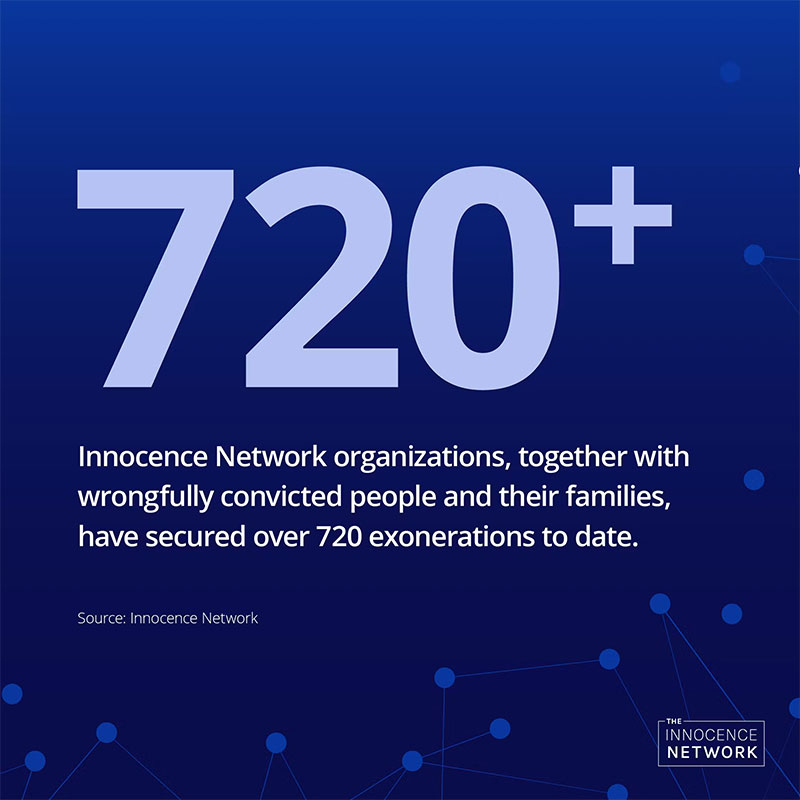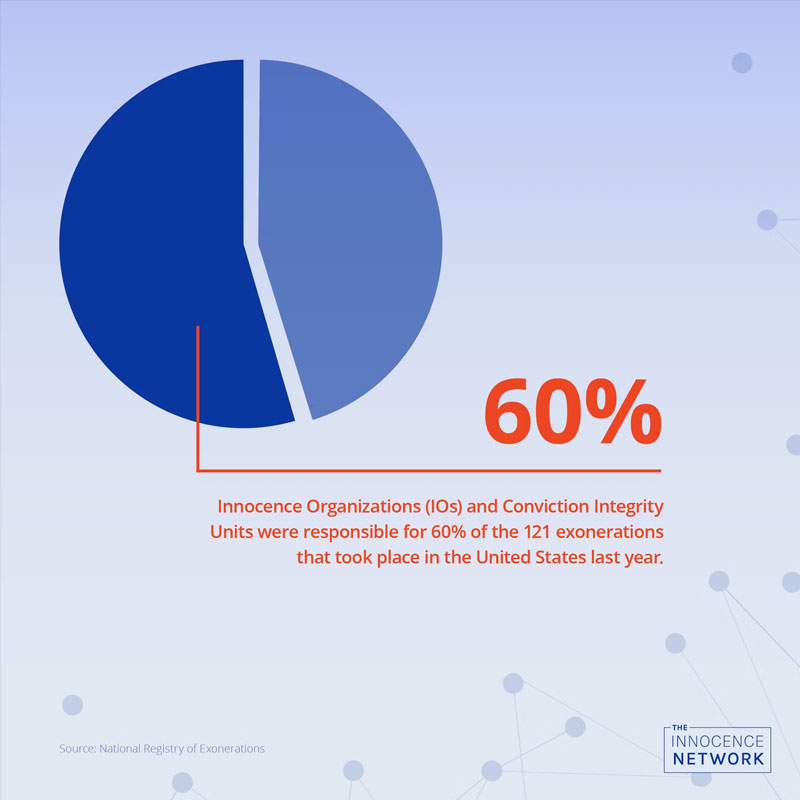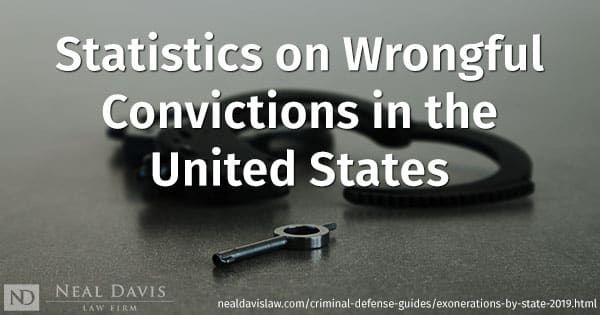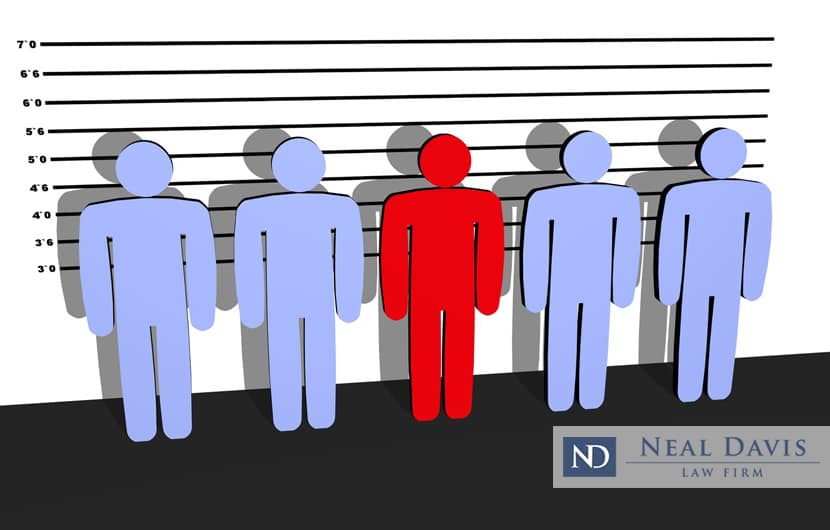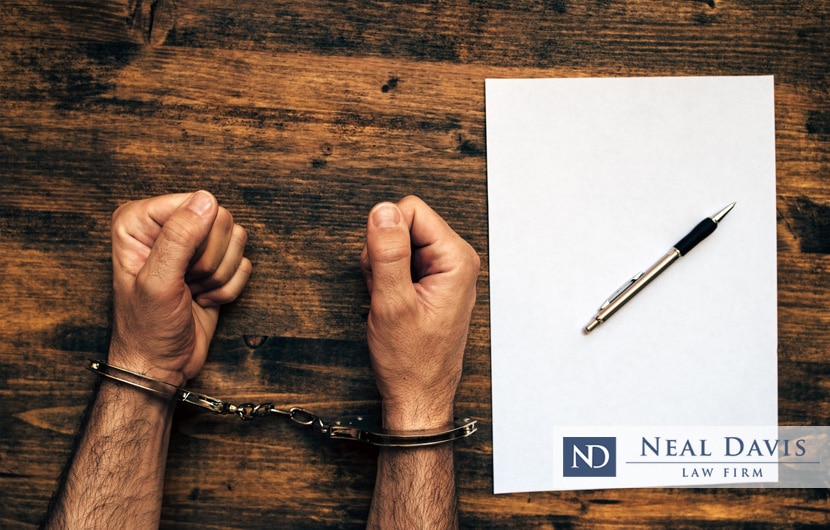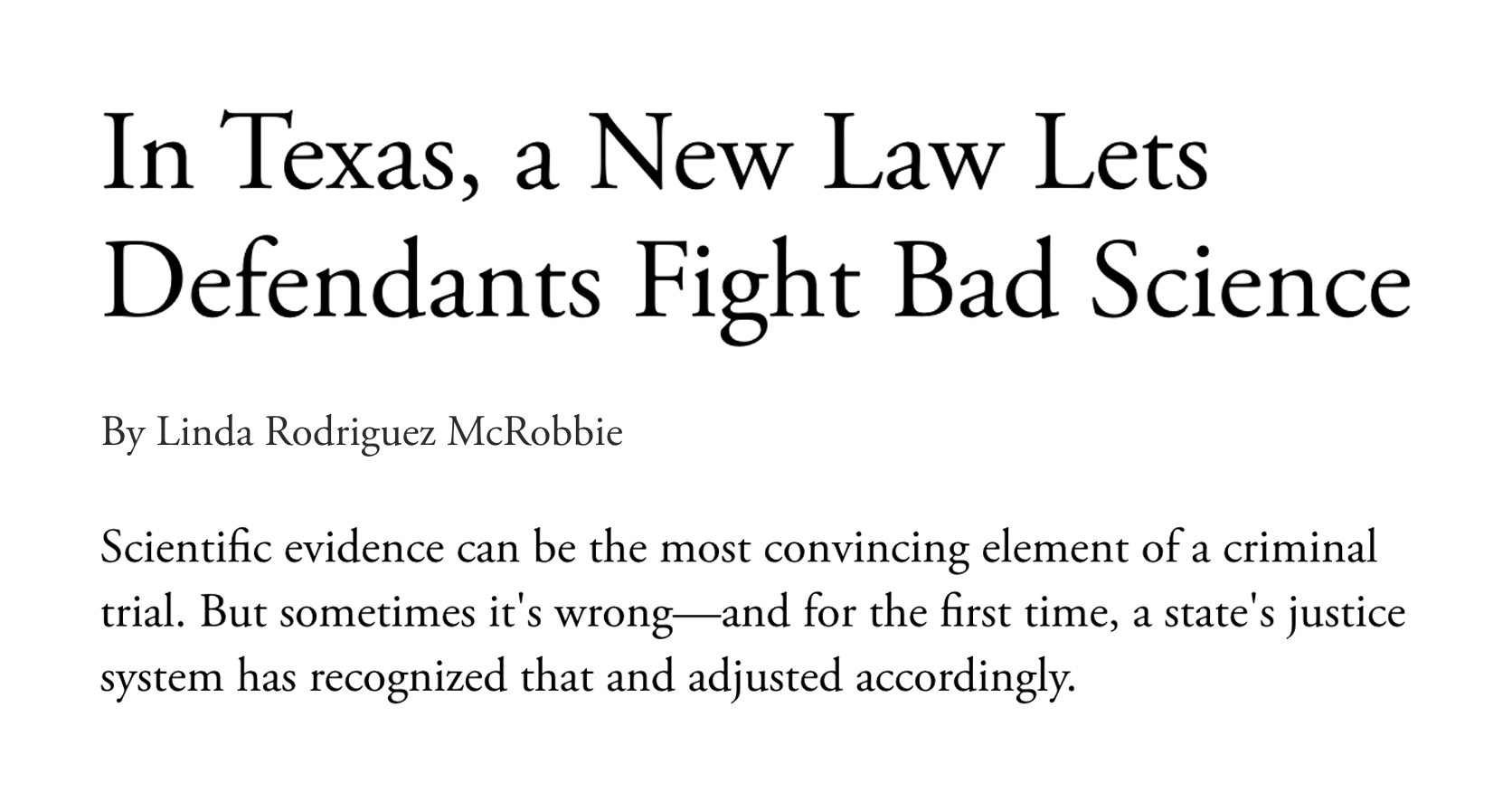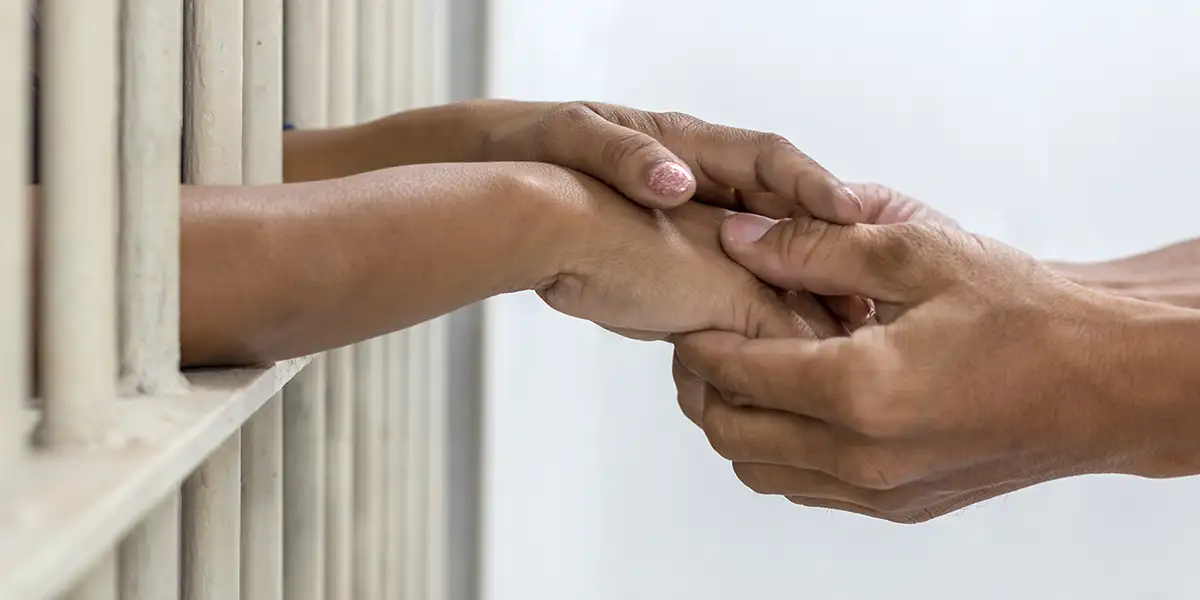
Wrongful Convictions: An American Epidemic
Why wrongful convictions are rising, and what we can do to stop them
Any criminal justice system is only as effective as its accuracy and the integrity of its officers. Unfortunately, no criminal justice system is infallible, as they are all controlled and run by humans. However, that is no excuse when people’s very lives are often at stake when it comes to convicting the wrong individual.
Images courtesy of wrongfulconvictionday.org
Are wrongful convictions increasing or decreasing in the U.S.?
Even with all the light that has been shed on false convictions over the past several years, wrongful convictions and exonerations have been steadily rising in the U.S.
According to data from the National Registry of Exonerations, a total of 238* wrongfully convicted people were exonerated in the U.S. in 2022 alone—that’s more than 5 people every week. This is the highest number of exonerations on record, beating the previous high of 185 exonerations back in 2016.
*Updated data as of May 18, 2023
Disturbingly, these innocent individuals spent an average of 12 years behind bars before being exonerated. Also disturbing is the fact that these numbers don’t even take into account “group exonerations,” in which tens of thousands more were cleared where cases of corruption involving law enforcement were involved.
Exonerations by state report: Wrongful conviction
statistics in the US
Since 1989, numerous injustices have led to more than 21,000 years lost in prison for persons who later were exonerated. A total of 2,468 people were exonerated between 1989 and 2019. Learn more
Can the number of innocent inmates really be accurately estimated?
The truth is that determining the precise number of individuals who have been wrongfully convicted of a crime and sentenced to incarceration is practically impossible. The volume of records that would have to be reviewed would be overwhelming, and that would just be the tip of the iceberg.
There are still more cases that, for one reason or another, never made it to the trial stage. There are virtually no records of these cases. It’s estimated that plea bargains are reached in nearly 95% of convictions, making a court trial unnecessary.
How are people wrongfully convicted?
The National Institute of Justice defines a wrongful conviction in 2 ways:
- When a person is factually innocent of the charges they have been convicted of, or
- When a person’s rights have been violated by procedural errors during the conviction process.
- Tainted eyewitness identification
- False confessions
- Police and prosecutorial misconduct
- Flawed forensic evidence
- Perjured testimony
Please note that the statistics used below are based on information from the 2022 National Registry of Exonerations Annual Report. While we strive to provide the most accurate information possible, be aware that current data may have changed.
Tainted eyewitness identification
Eyewitnesses to crimes can be crucial in obtaining a conviction. Unfortunately, there are eyewitnesses who make mistakes—sometimes honest ones—that lead to the wrong person being convicted.
There are also people who, for whatever reason, deliberately lie and accuse an innocent person of committing a crime.
Sadly, more and more cases are being exposed in which police officers, probation officers or others in positions of authority are the ones deliberately making these false accusations and sending innocent people to prison.
Other situations have come to light in which a police officer or probation officer has strong-armed someone into claiming they witnessed someone commit a crime by threatening them or a family member with trumped-up criminal charges or other punishment if they refused to cooperate.
The exoneration of 61-year-old New Yorker Anthony Broadwater highlights the need for reform when it comes to eyewitness identifications and police lineups.
In 1997, 23-year-old Martin Santillan was arrested for a murder that he did not commit. The prosecution’s case was based on an identification by an eyewitness who admitted to drinking throughout the day and night of the shooting. (1/2) pic.twitter.com/oHdoAGMNpB
— Natl. Registry of Exonerations (@exonerationlist) April 11, 2023
False confessions
Why would anyone confess to a crime they didn’t commit?
There are a few explanations. If a person is mentally incapacitated to some degree, then they may confess to a crime without really understanding what they’re doing. Other people confess because they want the notoriety and attention that come from confessing, particularly if it’s a high-profile case.
In a great many cases, however, people are tricked or harassed—and sometimes even tortured—into confessing during police interrogations. If a person has never had any contact with the law, then it’s easy for them to become confused, scared and intimidated into answering questions in a way that indicates they’re guilty when, in fact, they’re not.
Perhaps you wonder if you need a lawyer or an attorney for a police interview or interrogation. Yes, is the answer.
Police and prosecutorial misconduct
According to a recent study, more than half of all false convictions can be attributed to misconduct by police officers, investigators, prosecutors and other agents of the legal system.
The extensive reach of possibilities for this type of misconduct is explained in several ways:
- When the investigation is in its early stages, police officers and detectives may use coercive suggestions when a witness is in the process of identifying a suspect. This is done to influence the witness to identify a specific suspect, whether that suspect is the one the witness actually saw or not.
- They may also employ unscrupulous interrogation methods to get a confession from a suspect whom they know is innocent.
- Police and investigators are also known to fabricate or “plant” evidence in order to arrest an innocent person.
- During the trial process, prosecutors may present perjured (dishonest) testimony and/or false evidence.
- They may also fail to present or allow evidence to be presented that is in the defendant’s favor and may help to prove their innocence. This is known as exculpatory evidence, and when concealed in such a way, it prevents the accused from receiving a fair trial.
In 1992, Lee Harris was sentenced to 90 years in prison for murder. Starting in 2003, his former cellmate Robert Chattler fought to uncover the voluminous evidence that police officers had falsified evidence, intimidated witnesses, and lied that Harris confessed. (1/2) pic.twitter.com/AOxz0mteKK
— Natl. Registry of Exonerations (@exonerationlist) April 26, 2023
Flawed forensic evidence
In almost one-quarter of the cases in the U.S. that have resulted in exonerations, misleading or outright false forensic evidence has been responsible to some degree in the conviction of the innocent person.
Forensic evidence is based on scientific theory and analysis, meaning that in order to be valid and accurate, it has to undergo a thorough scientific testing process.
However, the majority of forensic methods that are used in criminal investigations have been created by law enforcement and haven’t been subjected to the necessary scientific processes that would give them the accuracy needed to gain a legitimate criminal conviction. Many of the disciplines are nothing more than what is referred to as “junk science,” meaning that their results are often not valid.
Another type of flawed forensic evidence involves legitimate human error. Crime scene specimens and evidence can become contaminated, mixed up or lost when improperly handled or preserved. It also isn’t unheard of for forensic analysts to deliberately fabricate test results, report test results without even performing any tests or conceal exculpatory evidence.
“Junk science” refers to unvalidated, unreliable, or discredited scientific methods, techniques, or evidence that are improperly used in criminal investigations or trials.
The use of such science can lead to wrongful convictions by providing inaccurate or misleading information, which can sway a jury or judge to render a verdict based on false premises.
Examples of junk science in delivering wrongful verdicts might include the misuse of forensic techniques like bite mark analysis, hair comparison, or arson investigation methods that do not adhere to current scientific standards.
The impact of junk science on wrongful convictions can be significant, as it undermines the integrity of the criminal justice system and can lead to innocent people being convicted for crimes they did not commit.
Efforts to address this issue include improving the scientific rigor of forensic disciplines, establishing stricter standards for expert witness testimony, and providing resources for the reevaluation of cases that may have been influenced by junk science.
Passed in 2013, this law allows prisoners to challenge their convictions based on the use of questionable evidence or flawed forensic science.
The law amends the Texas Code of Criminal Procedure, expanding a prisoner’s right to apply for a “writ of habeas corpus” based on scientific evidence. Before the law, obtaining such a writ was difficult, even with new scientific evidence proving innocence.
Writ: A written judicial order ordering someone to do something, or cease to do something.
Habeas Corpus: Latin for “you have the body.” In criminal law, habeas corpus is a writ forcing law enforcement officers to bring forward a prisoner they are holding and provide a reason why the prisoner should still be detained. Habeas corpus is commonly filed by prisoners who believe their constitutional rights have been violated by state officials.
Now, prisoners can gain a writ of habeas corpus if the relevant scientific evidence was not available at the time of their conviction and if the current evidence would have prevented their conviction had it been presented at the original trial.
Courts must grant relief when new scientific evidence is revealed or when the scientific evidence used to convict has been proven false, misleading, or inaccurately applied.
Texas’ junk science law has already helped some prisoners gain their freedom. It has been praised as “elegant, straightforward, and phenomenally important” by Mike Snedeker, criminal defense lawyer and president of the nonprofit National Center for Reason and Justice.
“The new statute offers another kind of clarity: “It’s important because a lot of really shaky evidence is clothed in objectivity,” said Snedeker, noting the incalculable impact expert testimony can have on a juror’s decision-making—especially expert testimony characterized as scientific or medical. “Our priests now are scientists, doctors,” said Snedeker.
By giving defendants a way to question the sacrosanctity of scientific testimony, the court recognizes that science and medicine are mutable and continually evolving.“
Source: The Atlantic: In Texas, a New Law Lets Defendants Fight Bad Science, By Linda Rodriguez McRobbie
Perjured testimony
The discovery of perjured, or false, testimony from prosecution witnesses has been responsible for many exonerations to date. Witnesses most often offer up phony testimony in exchange for something they want, such as having their own criminal charges or jail sentences dropped or reduced. They may also fear retaliation from the police if they don’t provide the false testimony the police want.
In most instances, the jury, judge, and defendant never even know about this type of activity. In the rare instances when it’s discovered, it can be grounds for an appeal of the conviction, which often leads to a full exoneration.
Arson leaves 4 dead — three of them under 4 years old — and another child burned over 3/4s of her body. The wrong man charged, based on perjured testimony. A decade later, no justice. @RobertGavinTU recounts the bizarre tale of the Hulett Street fire. https://t.co/J2FEYIYtBe
— Casey Seiler (@CaseySeiler) May 2, 2023
The Registry recorded 233 exonerations in 2022, with new and old exonerations being added regularly.
The 233 exonerees in 2022 lost an average of 9.6 years to wrongful imprisonment, totaling 2,245 years.
At least 195 of the 233 exonerations in 2022 involved official misconduct, including 78% of murder exonerations (63 cases).
- Innocence Organizations (IOs) and Conviction Integrity Units (CIUs) played crucial roles in exoneration efforts.
- Together, IOs and CIUs were responsible for 171 exonerations (74% of the total).
- IOs participated in 160 exonerations, while CIUs contributed to 132 exonerations.
- In 2022, IOs and CIUs collaborated on 121 exonerations.
- 59% of the 233 exonerations in 2022 involved wrongful convictions where no crime occurred.
- 137 exonerations included cases of wrongful convictions for drug possession, murder, and child sex abuse.
| Overview of 2022 Exonerations | ||||||
|---|---|---|---|---|---|---|
| Crime | Exonerations | |||||
| Murder | 80 | |||||
| Manslaughter | 1 | |||||
| Sexual assault of an adult | 4 | |||||
| Child sex abuse | 12 | |||||
| Violent crimes (assault, robbery, attempted murder) | 20 | |||||
| Non violent crimes | 116 | |||||
How are the wrongfully convicted found innocent?
One of the most effective tools in exonerations is DNA testing. In cases where DNA was present at the crime scene, test results may have been hidden by the prosecution or never even tested at all. There is also the possibility that false results were presented at trial, resulting in a wrongful conviction.
In some older cases, DNA testing technology may not have been available yet. In these instances, DNA testing can be done post-conviction and has often resulted in the revelation of wrongful convictions. Unfortunately, these types of convictions have legal limitations when it comes to getting them overturned.
Petitions seeking exoneration may only be considered by an appeals court if specific types of evidence can be shown. These cases must typically involve DNA evidence that has been discovered post-conviction, proof of police or prosecutorial misconduct, or other significant evidence that supports taking another look at the case in the name of justice.
Maurice Hastings was incarcerated for 38 years before being exonerated by previously untested DNA evidence in 2022—more than two decades after he first asked the district attorney’s office to conduct the DNA testing. (1/4) pic.twitter.com/rQWEYAn7Pz
— Natl. Registry of Exonerations (@exonerationlist) February 10, 2023
Do wrongfully convicted individuals receive compensation?
There are a number of ways in which individuals exonerated of crimes after serving jail time may be able to receive compensation.
Compensation for federal crimes
The U.S. Congress passed the Justice for All Act in 2004, which guarantees those who have been exonerated of federal crimes $50,000 for each year they spent in prison and $100,000 for each year they spent on death row.
Compensation through civil lawsuits
In some cases, compensation can also be pursued via a civil lawsuit. These are filed in a federal court and focus on a person acting on behalf of the state (a prosecutor, the police, forensic analysts, etc.) who took part in unconstitutional misconduct that resulted in the exonerated individual’s federal rights being violated.
Compensation for crimes in Texas
In Texas, wrongful conviction cases can result in the exonerated individual receiving millions of dollars in compensation. The current Texas legal standard pays lump sums to exonerated individuals in the amount of $80,000 per year for every year they were incarcerated. Further, they can also receive annuity payments, paid monthly, totaling another $80,000 per year for the rest of their life, as long as they are never convicted of another felony.
Compensation for state crimes
The compensation available (if any) for those individuals exonerated of state crimes varies from state to state. As of June 2022, compensation statutes have been enacted in 38 states as well as the District of Columbia. However, the exonerated individuals in these states must prove their innocence either with clear, convincing evidence or by a preponderance of the evidence.
How does race factor into wrongful convictions?
The National Registry of Exonerations’s Race and Wrongful Convictions report, dated September 2022, reveals that racially motivated false convictions in the U.S. have reached shockingly high levels.
These cases of wrongful conviction were found to be the result of corruption across all levels of the legal system, including police, prosecutors, forensic technicians, judges and others.
In Texas, what role does the government play in wrongful convictions?
Over the past several years, a pattern of government misconduct has emerged in the state of Texas. The Innocence Project of Texas has uncovered evidence of consistent misconduct, negligence, fraud and other criminal conduct by government employees that have sent many innocent people to prison or, in the most horrifying cases, to the electric chair.
In fact, according to their data, the number of wrongfully convicted in Texas is estimated between 2% and 6%, meaning that there are 3,000 to 9,000 innocent people currently imprisoned in Texas.
How can wrongful convictions be prevented?
The answer to preventing wrongful convictions involves continued media attention on the subject as well as public awareness and involvement in exposing this epidemic and the officials involved in perpetuating it.
Those who are involved in falsely convicting innocent citizens must be held accountable and punished for their criminal actions. Supporting groups like the Innocence Project and Partners for Justice is also instrumental in discovering and overturning false convictions. Their work has helped to shed light on thousands of these cases and free innocent people.
Additionally, you can never underestimate the importance of having an experienced criminal defense attorney to assist the accused early on in the process. They can call into question false evidence and claims and fight for the accused person’s legal rights to prevent their wrongful conviction in the first place.
“Justice is about truth, fairness and the core principle of ‘innocent until proven guilty.’ Yet, in the US, devastating wrongful convictions challenge this tenet. Innocent people were put behind bars, forcing them to endure undeserved hardship for crimes they did not commit.
Some suffer for years before their innocence is proven. While exoneration brings freedom, it doesn’t erase the scars of their experiences or restore the time lost.
As defense attorneys, our mission aligns with this principle: to ensure that guilt is proven, not presumed, so that the innocent remain free. Every effort must be taken to prevent such injustices – no innocent person should ever face this ordeal.”
– Neal Davis
